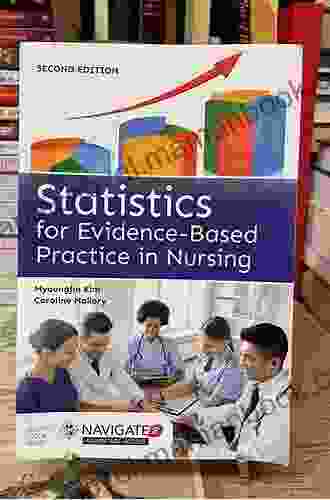Statistics for Evidence-Based Practice in Nursing: A Comprehensive Guide

Evidence-based practice (EBP) is a process that uses scientific evidence to guide clinical decision-making. It is an essential component of nursing practice, as it helps nurses to provide safe, effective, and timely care to their patients.
4.4 out of 5
| Language | : | English |
| File size | : | 143407 KB |
| Text-to-Speech | : | Enabled |
| Screen Reader | : | Supported |
| Enhanced typesetting | : | Enabled |
| Print length | : | 500 pages |
Statistics play a key role in EBP. They are used to collect, analyze, and interpret data, which can then be used to make informed decisions about patient care. Nurses need to have a strong understanding of statistics in order to effectively use EBP.
This article provides a comprehensive overview of statistics for EBP in nursing. We will cover the following topics:
- Basic statistical concepts
- Statistical methods for data collection and analysis
- Critical appraisal of research studies
- Applications of statistics in EBP
Basic Statistical Concepts
Before we can discuss statistical methods, it is important to review some basic statistical concepts.
Population and Sample
A population is a group of individuals who share a common characteristic. A sample is a subset of the population that is used to make inferences about the population.
Variables
A variable is a characteristic that can take on different values. Examples of variables include age, gender, race, and blood pressure.
Data
Data is a set of observations on a variable. For example, a nurse might collect data on the blood pressure of a group of patients.
Measures of Central Tendency
Measures of central tendency describe the center of a distribution of data. The most common measures of central tendency are the mean, median, and mode.
- The mean is the average of a set of data.
- The median is the middle value of a set of data.
- The mode is the most frequently occurring value in a set of data.
Measures of Variability
Measures of variability describe the spread of a distribution of data. The most common measures of variability are the range, variance, and standard deviation.
- The range is the difference between the largest and smallest values in a set of data.
- The variance is the average of the squared differences between each data point and the mean.
- The standard deviation is the square root of the variance.
Probability
Probability is a measure of the likelihood that an event will occur. It is expressed as a number between 0 and 1, where 0 indicates that the event is impossible and 1 indicates that the event is certain.
Statistical Methods for Data Collection and Analysis
There are a variety of statistical methods that can be used to collect and analyze data. The choice of method depends on the type of data being collected and the research question being asked.
Descriptive Statistics
Descriptive statistics are used to summarize data and describe the distribution of variables. Common descriptive statistics include measures of central tendency, measures of variability, and frequency distributions.
Inferential Statistics
Inferential statistics are used to make inferences about a population based on a sample. Common inferential statistics include hypothesis testing, confidence intervals, and regression analysis.
Data Collection Methods
There are a variety of methods that can be used to collect data for EBP, including:
- Surveys
- Interviews
- Observational studies
- Experimental studies
Data Analysis Methods
Once data has been collected, it can be analyzed using statistical methods. Common data analysis methods include:
- Descriptive statistics
- Inferential statistics
- Regression analysis
- Meta-analysis
Critical Appraisal of Research Studies
When using research evidence to make clinical decisions, it is important to critically appraise the studies that the evidence comes from. Critical appraisal is a process of evaluating the quality of a research study to determine whether it is valid and reliable.
There are a number of criteria that can be used to critically appraise a research study, including:
- The research question
- The study design
- The sample size
- The data collection methods
- The data analysis methods
- The s
Applications of Statistics in EBP
Statistics are used in a variety of ways in EBP. Some common applications include:
- Identifying patient populations at high risk for a particular condition
- Developing and evaluating interventions to improve patient outcomes
- Conducting research to generate new knowledge about nursing practice
- Making informed clinical decisions about patient care
Statistics are an essential tool for EBP in nursing. They can be used to collect, analyze, and interpret data, which can then be used to make informed decisions about patient care. Nurses need to have a strong understanding of statistics in order to effectively use EBP.
4.4 out of 5
| Language | : | English |
| File size | : | 143407 KB |
| Text-to-Speech | : | Enabled |
| Screen Reader | : | Supported |
| Enhanced typesetting | : | Enabled |
| Print length | : | 500 pages |
Do you want to contribute by writing guest posts on this blog?
Please contact us and send us a resume of previous articles that you have written.
 Top Book
Top Book Novel
Novel Fiction
Fiction Nonfiction
Nonfiction Literature
Literature Paperback
Paperback Hardcover
Hardcover E-book
E-book Audiobook
Audiobook Bestseller
Bestseller Classic
Classic Mystery
Mystery Thriller
Thriller Romance
Romance Fantasy
Fantasy Science Fiction
Science Fiction Biography
Biography Memoir
Memoir Autobiography
Autobiography Poetry
Poetry Drama
Drama Historical Fiction
Historical Fiction Self-help
Self-help Young Adult
Young Adult Childrens Books
Childrens Books Graphic Novel
Graphic Novel Anthology
Anthology Series
Series Encyclopedia
Encyclopedia Reference
Reference Guidebook
Guidebook Textbook
Textbook Workbook
Workbook Journal
Journal Diary
Diary Manuscript
Manuscript Folio
Folio Pulp Fiction
Pulp Fiction Short Stories
Short Stories Fairy Tales
Fairy Tales Fables
Fables Mythology
Mythology Philosophy
Philosophy Religion
Religion Spirituality
Spirituality Essays
Essays Critique
Critique Commentary
Commentary Glossary
Glossary Bibliography
Bibliography Index
Index Table of Contents
Table of Contents Preface
Preface Introduction
Introduction Foreword
Foreword Afterword
Afterword Appendices
Appendices Annotations
Annotations Footnotes
Footnotes Epilogue
Epilogue Prologue
Prologue Andrea Girolamo Gallo
Andrea Girolamo Gallo Elizabeth Hill
Elizabeth Hill Joel Austin
Joel Austin Michael B Berkman
Michael B Berkman Stephen G Bloom
Stephen G Bloom Philip Vassallo
Philip Vassallo Stephen Kinzer
Stephen Kinzer Simon Northouse
Simon Northouse Andrew Davis
Andrew Davis Rick Riordan
Rick Riordan Carol Lea Benjamin
Carol Lea Benjamin Amy Alves
Amy Alves Ayushee Roy
Ayushee Roy Georgina Devon
Georgina Devon Ezra Meeker
Ezra Meeker Christy Oslund
Christy Oslund Kwame Nyong O
Kwame Nyong O Rolf Kenmo
Rolf Kenmo Myoungjin Kim
Myoungjin Kim Amy Medling
Amy Medling
Light bulbAdvertise smarter! Our strategic ad space ensures maximum exposure. Reserve your spot today!

 Robert HeinleinMastering the Fundamentals: A Comprehensive Guide to the Alfred Basic Piano...
Robert HeinleinMastering the Fundamentals: A Comprehensive Guide to the Alfred Basic Piano...
 Simon MitchellThe Future Seems Dirty: Explorations into a Shifting Climate and Polluted...
Simon MitchellThe Future Seems Dirty: Explorations into a Shifting Climate and Polluted...
 Dwight BellStories and Recipes to Share with Family and Friends: Building Memories and...
Dwight BellStories and Recipes to Share with Family and Friends: Building Memories and...
 Bruce SnyderUnveiling the Destructive Power of Family Wealth: A Comprehensive Examination...
Bruce SnyderUnveiling the Destructive Power of Family Wealth: A Comprehensive Examination... Jason ReedFollow ·7.4k
Jason ReedFollow ·7.4k Darnell MitchellFollow ·13.4k
Darnell MitchellFollow ·13.4k Pete BlairFollow ·16.7k
Pete BlairFollow ·16.7k Henry Wadsworth LongfellowFollow ·10.4k
Henry Wadsworth LongfellowFollow ·10.4k Heath PowellFollow ·14.5k
Heath PowellFollow ·14.5k Alexander BlairFollow ·9.2k
Alexander BlairFollow ·9.2k George OrwellFollow ·10.3k
George OrwellFollow ·10.3k Robert ReedFollow ·15.4k
Robert ReedFollow ·15.4k

 Rex Hayes
Rex HayesWorld of Dead Volume Issue: An In-Depth Analysis
The World of Dead volume issue...

 Nathan Reed
Nathan ReedHard Lessons Learned from ERP Rollouts: A Hivemind...
Enterprise...

 Fernando Bell
Fernando BellWith the Light, Vol. 1: Illuminating the Extraordinary...
The advent of parenthood is a...

 Wesley Reed
Wesley ReedNo Helping Hand: True Story of Deadly Waves
In December 2004,...

 Ruben Cox
Ruben CoxIntroduction to Electrodynamics by David Griffiths: A...
to Electrodynamics by...
4.4 out of 5
| Language | : | English |
| File size | : | 143407 KB |
| Text-to-Speech | : | Enabled |
| Screen Reader | : | Supported |
| Enhanced typesetting | : | Enabled |
| Print length | : | 500 pages |






